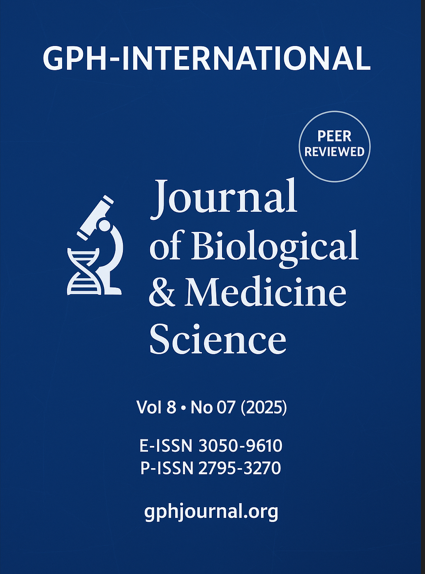Benefit from integrating zinc oxide nanoparticles with probiotic bacteria to produce strong Biofertilizer for increasing the production of agricultural crops, vegetables and fruits
Abstract
In this research, new methods were found to produce a strong, In this study, zinc oxide useful and usable biofertilizer in any agricultural soil and with any agricultural crop, whether fruit or vegetables, which is Nanoparticles is combined and it is incubated and prepared with some important nutrients for the growth and reproduction of the probiotic bacteria microorganisms present together to produce a biofertilizer and organic fertilizer rich in important nutrients for plant growth and increased production of agricultural crops, A mixed and combined nutritional medium of many materials and vegetables and fruits. nutrients suitable for the purpose of growing many living microorganisms such as bacteria and fungi and controlling the growth rates of microorganisms with the percentage of food present in the biofertilizer (F/M Ratio ).It was reached to increase the efficiency of agricultural fertilizer production, the work of biological fertilizers, and the production of a new strong and effective biological product in increasing the production of agricultural crops and supplying the plant with what it needs from important nutrients to increase growth, early production and improve the quality of agricultural soil. The main goal of adding many food media is the multiplicity and diversity of the carbon source, the multiplication of the growth of microbial isolates, the increase in their numbers, the reduction of growth, reproduction and regeneration quickly, and to reach an increase in the efficiency and effectiveness of biological fertilizer for soil and plants together, as it is considered an integrated nutrient medium. Biofertilizers, a sustainable ecofriendly agricultural approach to crop improvement is used to supplement chemical fertilizers mainly to maintain soil fertility. Continuous application of expensive chemical fertilizers causes reduction of organic matter content in soil and also microbial activity drastically. Biofertilizers are organic, biodegradable. They contain micro-organisms, provide nutrients viz., N, P, K and other nutrients, antibiotics, hormones like auxins, cytokinin, vitamins which enrich root rhizosphere. The present article highlights biofertilizer mediated crop functional such as plant growth and productivity, nutrient profile, plant protection and there by crop improvement. The knowledge gained from the literature appraised here in will help us to understand the physiological bases of biofertilizers towards sustainable agriculture in reducing problems associated with the use of chemicals fertilizers. Therefore, there is an urgent need to adapt biological sciences applications in agriculture field. Biotechnology is an amalgamation of variety of disciplines- molecular biology, bioinformatics, biochemistry, genetics and microbiology. The usage of combinations of these disciplines in agricultural field leads to generation of biotech crops with increased yield and enhanced quality. Agriculture biotechnology not only upgrades the quality but also utilizes the resources and livestock for the well-being of animals and wild plants. Phosphorus, Probiotic bacteria with yoghurt and sugar Charcoal sodium chloride and some other nutrients such as flour and starch are mixed with zinc oxide nano particles to produce a bio-fertilizer fully of nutrients necessary for plant growth, increase the production of agricultural crops, which improve the quality characteristics of agricultural soil, treat stress and poor production and some agricultural pests that may negatively affect plant growth and work to reduce the rate of increase of agricultural crops, vegetables and fruits , and so it is necessary to find alternative strategy to increase availability of nutrients for plants. One possible way could be application of so called bioeffectors (BE) which should improve the mobilization of nutrients (especially phosphorus) from less available forms in soil, improve plant growth and contribute to mycorrhiza development. BEs are commercially supplied products which contain active substances (live microorganisms and active natural compounds). BEs can be used in organic agriculture, because their application represents no risk for the environment.
Downloads
References
• 4. Mayak S, Tirosh T, Glick BR (2004) Plant growth-promoting bacteria confer resistance in tomato plants to salt stress. Plant Physiol Biochem 42: 565–572.
• 5. Singh JS, Pandey VC, Singh DP (2011) Efficient soil microorganisms: A new dimension for sustainable agriculture and environmental development. Agric Ecosyst Environ 140: 339–353.
• 6. Gomez CG, Valero NV, Brigard RC (2012) Halotolerant/alkalophilic bacteria associated with the cyanobacterium Arthrospira platensis (Nordstedt) Gomont that promote early growth in Sorghum bicolor (L.). Moench Agron Colomb 30: 111–115.
• 13. Waqas M, Khan AL, Kamran M, et al. (2012) Endophytic fungi produce gibberellins and indoleacetic acid and promotes host-plant growth during stress. Molecules 17: 10754–10773.
• 14. Khan AL, Hamayun M, Ahmad N, et al. (2011) Exophiala sp. LHL08 reprograms Cucumis sativus to higher growth under abiotic stresses. Physiol Plant 143: 329–343.
• 15. Khan AL, Hamayun M, Ahmad N, et al. (2011) Salinity stress resistance offered by endophytic fungal interaction between Penicillium minioluteum LHL09 and glycine max. L. J Microbiol Biotechnol 21: 893–902.
• 16. De Palma M, D’Agostino N, Proietti S, et al. (2016) Suppression Subtractive Hybridization analysis provides new insights into the tomato (Solanum lycopersicum L.) response to the plant probiotic microorganism Trichoderma longibrachiatum MK1. J Plant Physiol 190: 79–94.
• 26.IbrahimF.RuvioS.GranlundL.SalminenS.ViitanenM.OuwehandA.
C. 2010 Probiotics and Immunosenescence: Cheese as a Carrier. FEMS immunol. med. microbiol. 59 1 5359 .
• 27.TwetmanS.Stecksen-Blicks 2008 (2008) Probiotics and Oral Health Effects in Children. Int. j. paediatr. dent. 18 310 .
• 28.KrehbielC. R.RustS. R.ZhangG.GillilandS. E. 2003 Bacterial Direct-fed Microbials in Ruminant Diets: Performance Response and Mode of Action. J. anim. sci. 81(14). Electronic Supplement (2), E120.
• 29.KalavathyR.AbdullahN.JalaludinS.HoY. W. 2003 Effects of Lactobacillus Cultures on Growth Performance, Abdominal Fat Deposition, Serum Lipids and Weight of Organs of Broiler Chickens. Br. poult. sci. 44(1), 139-144.
• 30.PattersonJ.Burkholder 2003 (2003) Application of Prebiotics and Probiotics in Poultry Production. Poult. sci. 82 627631 .
• 31.VineN.LeukesW.KaiserH.DayaS.BaxterJ.Hecht 2004 (2004) Competition for Attachment of Aquaculture Candidate Probiotic and Pathogenic Bacteria on Fish Intestinal Mucus. J. fish dis. 27 319326 .
• 32.JinL.MarquardtR.Zhao 2000 (2000) A strain of Enterococcus faecium (18C23) Inhibits Adhesion of Enterotoxigenic Escherichia coli K88 to Porcine Small Intestine Mucus. Appl. environ. microb. 66 42004204 .
• 33.Wang YB 2007 Effect of Probiotics on Growth Performance and Digestive Enzyme Activity of the Shrimp Penaeus vannamei. Aquacult. 269 259264 .
• 34.HooperL. V.MidtvedtT.Gordon 2002 (2002) How Host-microbial Interactions Shape the Nutrient Environment of the Mammalian Intestine. Annu. rev.
nutr. 22 283307 .
• 35.MusaH.WuS.ZhuC.SeriH.Zhu 2009 (2009) The Potential Benefits of Probiotics in Animal Production and Health. J. anim. vet. adv. 8 313321 .
• 36.BalcázarJ. L.Rojas-LunaT.CunninghamD. P. 2007 Effect of the Addition of Four Potential Probiotic Strains on the Survival of Pacific White Shrimp (Litopenaeus vannamei) Following Immersion Challenge with Vibrio parahaemolyticus. J. invertebr. pathol. 96 147150 .
• 37.BalcázarJ. L.De BlasI.Ruiz-ZarzuelaI.VendrellD.GironésO.MuzquizJ.
L. 2007 Enhancement of the Immune Response and Protection Induced by Probiotic Lactic Acid Bacteria against Furunculosis in Rainbow Trout (Oncorhynchus mykiss). FEMS immunol. med. microbiol. 51 185193 .
• 38.Berg 2009 (2009) Plant-microbe Interactions Promoting Plant Growth and Health: Perspectives for Controlled Use of Microorganisms in Agriculture. Appl. microbiol. biot. 84 1118 .
• 39.Bloemberg GV, Lugtenberg BJJ 2001 Molecular Basis of Plant Growth Promotion and Biocontrol by rhizobacteria. Curr. opin. plant biol. 4 343350 .
• 40.Nelson LM 2004 Plant Growth Promoting Rhizobacteria (PGPR): Prospects for New Inoculants. Crop manage. doi.:10.1094/CM-2004-0301-05-RV.
• 41.SaleemM.ArshadM.HussainS.ASBhatti 2007 Perspective of Plant Growth Promoting Rhizobacteria (PGPR) Containing ACC Deaminase in Stress Agriculture.
J. ind. microbial. biot. 34 635648 .
• 42.Sheng XF, Xia JJ, Jiang CY, He LY, Qian 2008 (2008) Characterization of Heavy Metal-resistant Endophytic Bacteria from Rape (Brassica napus) Roots and Their Potential in Promoting the Growth and Lead Accumulation of Rape. Environ
pollut. 156 3 11641170 .
• 43.CompantS.ClémentC.Sessitsch 2010 (2010) Plant Growth-promoting Bacteria in the Rhizo-and Endosphere of Plants: Their Role, Colonization, Mechanisms Involved and Prospects for Utilization. Soil biol. biochem. 42 669678 .
• 44.PerrigD.BoieroM.MasciarelliO.PennaC.RuizO.CassánF.et al. 2007 Plant-growth- promoting Compounds Produced by Two Agronomically Important Strains of
Azospirillum brasilense, and Implications for Inoculant Formulation. Appl. microbiol. biot. 75 11431150 .
• 45.GardinerG.StantonC.LynchP.CollinsJ.FitzgeraldG.Ross 1999oss R (1999) Evaluation of Cheddar Cheese as a Food Carrier for Delivery of a Probiotic Strain to the Gastrointestinal Tract. J. dairy sci. 82 13791387 .
• 46.RossR.FitzgeraldG.CollinsK.Stanton 2002ollins K, Stanton C (2002) Cheese Delivering Biocultures: Probiotic Cheese. Aust. j. dairy technol. 57 7178 .
• 47.SaarelaM.VirkajärviI.AlakomiH. L.Sigvart-MattilaP.Mättö 2006 (2006) Stability and Functionality of freeze-dried Probiotic Bifidobacterium Cells during Storage in Juice and Milk. Int. dairy i. 16 14771482 .
• 48.PhillipsM.KailasapathyK.Tran 2006 (2006) Viability of Commercial Probiotic Cultures (L. acidophilus, Bifidobacterium sp., L. casei, L. paracasei, and L. rhamnosus) in Cheddar Cheese. Int i. food microbiol. 108 276280 .
• 49.AkınM.AkınM.Kırmacı 2007 (2007) Effects of Inulin and Sugar Levels on the Viability of Yogurt and Probiotic Bacteria and the Physical and Sensory Characteristics in Probiotic Ice-cream. Food chem. 104 9399 .
• 50.Akin MS 2005 Effects of Inulin and Different Sugar Levels on Viability of Probiotic Bacteria and the Physical and Sensory Characteristics of Probiotic Fermented Ice-cream. Milchwissenschaft. 60 297301 .
• 51.BaisH. P.WeirT. L.PerryL. G.GilroyS.VivancoJ. M. 2006 The role of Root Exudates in Rhizosphere Interactions with Plants and Other Organisms. Annu. rev. plant biol. 57 233266 .
• 52.ParvezS.MalikK.AhKang. S.KimH. Y. 2006 Probiotics and Their Fermented Food Products are Beneficial for Health. J. appl. microbiol. 100 11711185 .
• 53.Sanders ME, Klaenhammer 2001 (2001) Invited Review: The Scientific Basis of Lactobacillus acidophilus NCFM Functionality as a Probiotic. J. dairy
sci. 84 319331 .
• 54.Sanders ME, Huis in’t Veld 1999 (1999) Bringing a Probiotic-containing Functional Food to the Market: Microbiological, Product, Regulatory and Labeling Issues. Anton leeuw. 76 293315 .
• 55.Özer BH, Kirmaci HA 2010 Functional Milks and Dairy Beverages. Int. j. dairy technol. 63 115 .
• 56.SucciM.TremonteP.RealeA.SorrentinoE.GraziaL.PacificoS.et al. 2005 Bile Salt and Acid Tolerance of Lactobacillus rhamnosus Strains Isolated from Parmigiano Reggiano Cheese. Fems. microbiol. lett. 244 129137 .
• 57.SaarelaM.Paquin 2009aquin P (2009) Probiotics as Ingredients in Functional Beverages. In: Paquin P, editer. Functional and Speciality Beverage Technology. New York: CRC Press. 5570 .
• 58.Roy 2005 (2005) Technological Aspects Related To the Use of Bifidobacteria in Dairy Products. Le lait. 85 3956 .
• 59.Østlie HM, Helland MH, Narvhus JA 2003 Growth and Metabolism of Selected Strains of Probiotic Bacteria in Milk. Int. i. food microbiol. 87 1727 .
• 60.SendraE.FayosP.LarioY.Fernández-LópezJ.Sayas-BarberáE.Pérez-AlvarezJ.
A. 2008 Incorporation of Citrus Fibers in Fermented Milk Containing Probiotic Bacteria. Food microbiol. 25 1321 .
• 61.De BoeverP.WoutersR.Verstraete 2001outers R, Verstraete W (2001) Combined Use of Lactobacillus reuteri and Soygerm Powder as Food Supplement. Lett. appl. microbiol. 33 420424 .
• 62.ShimakawaY.MatsubaraS.YukiN.IkedaM.Ishikawa 2003 (2003) Evaluation of Bifidobacterium breve Strain Yakult-Fermented Soymilk as a Probiotic Food. Int. i. food microbial. 81 131136 .
• 63.StephenieW.KabeirB.ShuhaimiM.RosfarizanM.Yazid 2007 (2007) Growth Optimization of a Probiotic Candidate, Bifidobacterium pseudocatenulatum G4, in Milk Medium Using Response Surface Methodology. Biotechnol. bioproc. eng. 12 106113 .
• 64.JanerC.PelaezC.Requena 2004 (2004) Caseinomacropeptide and Whey Protein Concentrate Enhance Bifidobacterium lactis Growth in Milk. Food
chem. 86 263267 .
• 65.Martinez-VillaluengaC.FríasJ.GómezR.Vidal-Valverde 2006, Frías J, Gómez R, Vidal-Valverde C (2006) Influence of Addition of Raffinose Family Oligosaccharides on Probiotic Survival in Fermented Milk during Refrigerated Storage. Int. dairy i. 16 768774 .
• 66.DonkorO.HenrikssonA.VasiljevicT.Shah 2006 (2006) Effect of Acidification on the Activity of Probiotics in Yoghurt during Cold Storage. Int. dairy j. 16 11811189 .
• 67.TalwalkarA.Kailasapathy 2004ailasapathy K (2004) A Review of Oxygen Toxicity in Probiotic Yogurts: Influence on the Survival of Probiotic Bacteria and Protective Techniques. Compr. rev. food sci. f. 3 117124 .
• 68.DonkorO.NilminiS.StolicP.VasiljevicT.Shah 2007ilmini S, Stolic P, Vasiljevic T, Shah N (2007) Survival and Activity of Selected Probiotic Organisms in Set-type Yoghurt during Cold Storage. Int. dairy j. 17 657665 .
• 69.Aryana KJ, McGrew 2007 Quality Attributes of Yogurt with Lactobacillus casei and Various Prebiotics. LWT-Food sci technol. 40:1808-1814.
• 70.Dave RI, and Shah NP 1997 Effect of Cysteine on the Viability of Yoghurt and Probiotic Bacteria in Yoghurts Made with Commercial Starter Cultures. Int. dairy j. 7(8-9): 537-545.
• 71.SultanaK.GodwardG.ReynoldsN.AnimugaswainyR.PeirisP.Kailasapathy 2000, Godward G, Reynolds N, Animugaswainy R, Peiris P, and Kailasapathy K (2000) Encapsulation of Probiotic Bacteria with Alginate-starch and Evaluation of Survival in Simulated Gastrointestinal Conditions and In Yoghurt. Int. j. food microbiol. 62(1-2): 47-55.
• 72.KailasapathyK.BSSureeta 2004 Effect of Storage on Shelf Life and Viability of Freeze-dried and Microencapsulated Lactobacillus acidophilus and Bifidobacterium infantis cultures. Aust. j. dairy technol. 59 3 204208 .
• 73.PicotA.Lacroix 2004 (2004) Encapsulation of Bifidobacteria in Whey Proteinbased Microcapsules and Survival in Simulated Gastrointestinal Conditions and in Yoghurt. Int. dairy j. 14 6 505515 .
• 74.IyerC.Kailasapathy 2005ailasapathy K (2005) Effect of Co-encapsulation of Probiotics with Prebiotics on Increasing the Viability of Encapsulated Bacteria under in vitro Acidic and Bile Salt Conditions and in Yogurt. J. food sci. 70 1 1823 .
• 75.CapelaP.HayT. K. C.ShahN. P. 2006 Effect of Cryoprotectants, Prebiotics and Microencapsulation on Survival of Probiotic Organisms in Yogurt and Freeze-dried Yogurt. Food res. int. 39 2 203211 .
• 76.2006ailasapathy K (2006) Survival of Free and Encapsulated Probiotic Bacteria and Their Effect on the Sensory Properties of Yogurt. LWT- Food sci
technol. 39 10 12211227 .
• 77.OliveiraR. P. S.FlorenceA. C. R.SilvaR. C.PeregoP.ConvertiA.GioeilliL. A.OliveriaM. N. 2009 Effect of Different Prebiotics on the Fermentation Kinetics, Probiotic Survival and Fatty Acids Profiles in Nonfat Symbiotic Fermented Milk. Int. i. food microbio.128 3 467472 .
• 78.PaseepholT.Sherkat 2009 (2009) Probiotic Stability of Yoghurts Containing Jerusalem artichoke Insulin during Refrigerated Storage. J. funct. foods. 1 3 311318 .
• 79.Sandoval-CastillaO.Lobato-CallerosC.Garcia-GalllidoH. S.Alvarez- RainirezJ.Venion-CarterE. J. 2010 Textural Properties of Alginate-pectin Beads and Survivability of Entrapped Lb. casei in Simulated Gastrointestinal Conditions and in Yogurt. Food res. int. 43 1 111117 .
• 80.OngL.HenrikssonA.ShahN. P. 2007 Chemical Analysis and Sensory Evaluation of Cheddar Cheese Produced with Lactobacillus acidophilus, Lb. casei, Lb. paracasei or Bifidobacterium sp. Int dairy j. 17 937945 .
• 81.HellerK. J.BockelmannW.SchrezenmeirJ.De V. R. E. S. E. 2003 (2003) Cheese and Its Potential as a Probiotic Food. In: Farnworth E, editore. Handbook of Fermented Functional Foods. Boca Raton, CRC Press. 203225 .
• 82.MäkeläinenH.ForsstenS.OlliK.GranlundL.RautonenN.Ouwehand 2009 (2009) Probiotic Lactobacilli in a Semi-soft Cheese Survive in the Simulated Human Gastrointestinal Tract. Int. dairy j. 19 675683 .
• 83.VinderolaC.ProselloW.GhibertoD.Reinheimer 2000 (2000) Viability of Probiotic (Bifidobacterium, Lactobacillus acidophilus and Lactobacillus casei) and Nonprobiotic Microflora in Argentinian Fresco Cheese. J. dairy sci. 83 19051911 .
• 84.MäkeläinenH.IbrahimF.ForsstenS.JorgensenP.OuwehandA. C. 2010 Probiotic Cheese Devlopment and Functionality. Nutra. foods. 9 3 1519 .
• 85.Đurić MS, Iličić MD, Milanović SD, Carić MĐ, Tekić MN 2007 Nutritive Characteristics of Probiotic Quark as Influenced by Type of Starter. Acta periodica technologica. 38 1119 .
• 86.Aragon-AlegroL. C.AlarconAlegro. J. H.RobertaCardarelli. H.ChihChiu. M.IsaySaad. S. M. 2007 Potentially Probiotic and Synbiotic Chocolate Mousse. LWT-Food Sci. technol. 40 669675 .
• 87.WilsonE.SeoC.ShahbaziA.Ibrahim 2004eo C, Shahbazi A, Ibrahim S (2004) Survival and Growth of Probiotic Cultures in Sour Cream Products. IFT Annual Meeting. 17A.
• 88.Cruz AG, Antunes AEC, Sousa ALOP, Faria JAF, Saad SMI 2009 Ice-cream As a Probiotic Food Carrier. Food res. int. 42 12331239 .
• 89.Charalampopoulos D, Wang R, Pandiella S, Webb C (2002) Application of Cereals and Cereal Components in Functional Foods: a Review. Int. j. food microbiol. 79:131-141.
• 90.StantonC.DesmondC.CoakleyM.CollinsJ. K.FitzgeraldG.RossR.
P. 2003 Challenges Facing Development of Probiotic-Containing Functional Foods. In: Farnworth E, editor. Handbook of Fermented Functional Foods. Boca Raton: CRC Press. 2758 .
• 91.GranatoD.BrancoG. F.NazzaroF.CruzA. G.FariaJ. A. F. 2010 Functional Foods and Nondairy Probiotic Food Development: Trends, Concepts, and Products. Compr. rev. food sci. f. 9 292302 .
• 92.Rozada-SánchezR.SatturA. P.ThomasK.PandiellaS. S. 2008 Evaluation of Bifidobacterium spp. for the Production of a Potentially Probiotic Malt-based Beverage. Process biochem. 43 848854 .
• 93.AngelovA.GotchevaV.KunchevaR.Hristozova 2006 (2006) Development of a New Oat-based Probiotic Drink. Int. j. food microbiol. 112 7580 .
• 94.Champagne CP 2009 19 Some Technological Challenges in the Addition of Probiotic Bacteria to Foods. In: Charalampopoulos D, Rastall RA, editors. Prepiotics and Probiotics Science and Technology. New York: Springer. 761804 .
• 95.SavardT.GardnerN.Champagne 2003hampagne C (2003) Growth of Lactobacillus and Bifidobacterium Cultures in a Vegetable Juice Medium, and Their Stability during Storage in a Fermented Vegetable Juice. Sci. aliment. 23 2 273283 .
• 96.KunS.Rezessy-SzabóJ. M.NguyenQ. D.Hoschke 2008 (2008) Changes of Microbial Population and Some Components in Carrot Juice during Fermentation with Selected Bifidobacterium Strains. Process biochem. 43 816821 .
• 97.Yoon KY, Woodams EE, Hang YD 2006 Production of Probiotic Cabbage Juice by Lactic Acid Bacteria. Bioresource technol. 97 14271430 .
• 98.LeeS.JiG.Park 1999 (1999) The Viability of Bifidobacteria Introduced into Kimchi. Lett. appl. microbiol. 28 153156 .
99.Yoon KY, Woodams EE, Hang YD 2005 Fermentation of Beet Juice by Beneficial Lactic Acid Bacteria. LWT-Food sci. technol. 38 7375 .
• 100.Chou CC, Hou JW 2000 Growth of Bifidobacteria in Soymilk and Their Survival in the Fermented Soymilk Drink during Storage. Int. j. food microbiol. 56 113121 .
• 101.Wang YC, Yu RC, Chou CC 2002 Growth and Survival of Bifidobacteria and Lactic Acid Bacteria during the Fermentation and Storage of Cultured Soymilk Drinks. Food microbiol. 19 501508 .
• 102.Lin FM, Chiu CH, Pan TM 2004 Fermentation of a Milk-soymilk and Lycium chinense Miller Mixture using a New Isolate of Lactobacillus paracasei subsp. paracasei NTU101 and Bifidobacterium longum. J. ind. microbiol biot. 31 559564 .
• 103.Tsai J, Lin Y, Pan B, Chen T (2006) Antihypertensive Peptides and γ- aminobutyric Acid from Prozyme 6 Facilitated Lactic Acid Bacteria Fermentation of Soymilk. Process biochem. 41:1282-1288.
• 104.FotiouF.GoulasA.FountoulakisK.KoutlasE.HamlatzisP.PapakostopoulosD.et al. 1998 Characterization of Bifidobacterium Strains for Use in Soymilk Fermentation. Int. j. food microbiol. 39 213219 .
• 105.Yeo SK, Liong MT 2010 Effect of Prebiotics on Viability and Growth Characteristics of Probiotics in Soymilk. J. sci. food agr. 90 267275 .
• 106.Verbeke 2006 (2006) Functional Foods: Consumer Willingness to Compromise on Taste for Health? Food qual. prefer. 17 126131 .
• 107.TuorilaH.CardelloA. V. 2002 Consumer Responses to an Off-flavor in Juice in the Presence of Specific Health Claims. Food qual. prefer. 13 561569 .
• 108.LuckowT.Delahunty 2004 (2004) Consumer Acceptance of Orange Juice Containing Functional Ingredients. Food res. int. 37 805814 .
• 109.WangC. Y.NgC. C.SuH.TzengW. S.ShyuY. T. 2009 Probiotic Potential of Noni Juice Fermented with Lactic Acid Bacteria and Bifidobacteria. Int. j. food sci.
nutr. 60 98106 .
• 110.MousaviZ.MousaviS.RazaviS.Emam-DjomehZ.Kiani 2011 (2011) Fermentation of Pomegranate Juice by Probiotic Lactic Acid Bacteria. World j. microb.
biot. 27 123128 .
• 111.Pereiraa ALF, Maciela TC, Rodriguesa 2011 (2011) Probiotic Cashew Apple Juice. Int. congr. eng. food. 2011 16 .
• 112.Tsen JH, Lin YP, King VAE. 2003 Banana Puree Fermentation by Lactobacillus acidophilus Immobilized in Ca-alginate. J. gen. appl. microbiol.49 357361 .
• 113.KourkoutasY.XoliasV.KallisM.BezirtzoglouE.KanellakiM. 2005 Lactobacillus casei Cell Immobilization on Fruit Pieces for Probiotic Additive, Fermented Milk and Lactic Acid Production. Process biochem 40 411416 .
• 114.Charalampopoulos D, Pandiella S, Webb C (2002) Growth Studies of Potentially Probiotic Lactic Acid Bacteria in Cereal‐based Substrates. J appl. microbiol. 92:851-859.
• 115.SalovaaraH.Gänzle 2011 (2011) Lactic Acid Bacteria in Cereal-based Products. In: Lahtinen S, Salminen S, Ouwehand A, Wright A. Lactic Acid Bacteria: Microbiological and Functional Aspects. London: CRC Press. 227 245.
• 116.KediaG.WangR.PatelH.PandiellaS. S. 2007 Use of Mixed Cultures for the Fermentation of Cereal-based Substrates with Potential Probiotic Properties. Process biochem. 42 6570 .
• 117.GotchevaV.HristozovaE.HrostozovaT.GuoM.RoshkovaZ.Angelov 2002ngelov A (2002) Assessment of Potential Probiotic Properties of Lactic Acid Bacteria and Yeast Strains. Food biotechnol. 16 211225 .
• 118.Kedia].VázquezG.J. A. 2008 Pandiella SS. Fermentability of Whole Oat Flour, PeriTec Flour and Bran by Lactobacillus plantarum. J. food eng. 89 246249 .
119.MårtenssonO.AnderssonC.AnderssonK.ÖsteR.Holst 2001, Andersson C, Andersson K, Öste R, Holst O (2001) Formulation of an Oat‐based Fermented Product and Its Comparison with Yoghurt. J. sci food agr. 81 13141321 .
• 120.Wood PJ 1997 Functional Foods for Health: Opportunities for Novel Cereal Processes and Products. Cereal 8 233238 .
• 121.HellandM. H.WicklundT.NarvhusJ. A. 2004 Growth and Metabolism of Selected Strains of Probiotic Bacteria, in Maize Porridge with Added Malted Barley. Int. j. food microbiol. 91 305313 .
• 122.Gerez C, Cuezzo S, Rollán G, Font de Valdez G (2008) Lactobacillus reuteri CRL 1100 as Starter Culture for Wheat Dough Fermentation. Food microbiol. 25:253-259.
• 123.[123]Hammes. W.Hertel 1998 (1998) New Developments in Meat Starter Cultures. Meat sci. 49:S125 -S138.
• 124.Tyopponen S, Petaja E, Mattila-Sandholm T (2003) Bioprotectives and Probiotics for Dry Sausages. Int. j. food microbiol. 83:233-244.
• 125.Axelsson 2004 (2004) Lactic Acid Bacteria: Classification and Physiology. In: Salminen S, Wright A, Ouwehand AC, editors. Lactic Acid Bacteria: Microbiology and Functional Aspects. New York: Marcel Dekker. 166 .
• 126.2000eistner L (2000) Basic Aspects of Food Preservation by Hurdle Technology. Int. j. food microbiol. 55 181186 .
• 127.Lücke FK 2000 Utilization of Microbes to Process and Preserve Meat. Meat sci. 56 105115 .
• 128.ThapaN.PalJ.TamangJ. P. 2004 Microbial Diversity in Ngari, Hentak and Tungtap, Fermented Fish Products of North-East India. World j. microbiol. biotechnol. 20 599607 .
• 129.Botsoglou NA, Fletouris DJ, ebrary 2001 (2001) Drug Residues in Foods: Pharmacology, Food Safety, and Analysis. New York: Marcel Dekker. 516 p.
• 130.Langhout 2000 New Additives for Broiler Chickens. World poultry. 16(3): 22- 27.
• 131.Hashemipour H, Khaksar V, Kermanshahi H (2011) Application of Probiotic on Egg Production and Egg Quality of Chukar Partridge. Afr. j. biotechnol. 10(82):19244-19248.
• 132.KawakamiS.YamadT.NakanishiN.Cai 2010amad T, Nakanishi N, Cai Y (2010) Feedin of Lactic Acid Bacteria and Yeast on Growth and Diarrhea of Hostein Calves. J. Anim. Vet. Adv. 9 11121114 .
• 133.GaggìaF.MattarelliP.Biavati 2010iavati B (2010) Probiotics and Prebiotics in Animal Feeding for Safe Food Production. Int. j. Micribiol. 141:S15 -S28.
• 134.BalcázarJ. L.BlasI.Ruiz-ZarzuelaI.CunninghamD.VendrellD.MúzquizJ.
L. 2006 The Role of Probiotics in Aquaculture. Vet. microbiol. 114 173186 .
• 135.CassánF.MaialeS.MasciarelliO.VidalA.LunaV.Ruiz 2009, Vidal A, Luna V, Ruiz O (2009) Cadaverine Production by Azospirillum brasilense and Its Possible Role in Plant Growth Promotion and Osmotic Stress Mitigation. Eur. j. soil
biol. 45 1219 .
• 136.Long SR 2001 Genes and Signals in the Rhizobium-legume Symbiosis. Plant physiol. 125 6972 .
• 137.De VleesschauwerD.Hofte 2007 (2007) Using Serratia plymuthica to Control Fungal Pathogens of Plants. CAB Rev. 2 046 112 .
• 138.BaiY.D’AoustF.SmithD. L.DriscollB. T. 2002 Isolation of Plant-growth- promoting Bacillus Strains from Soybean Root Nodules. Can. j.
microbiol. 48 230238 .
• 139.Kloepper JW, Ryu CM, Zhang 2004 (2004) Induced Systemic Resistance and Promotion of Plant Growth by Bacillus spp. Phytopathology. 94 12591266 .
140.Preston GM 2004 Plant perceptions of plant growth-promoting Pseudomonas. Philos. Trans. R. Soc Lond. B. Biol. Sci. 359 907918 .
• 141.ZhaoY.ThilmonyR.BenderC. L.SchallerA.HeS. Y.HoweG. A. 2003 Virulence Systems of Pseudomonas Syringae pv. Tomato Promote Bacterial Speck Disease in Tomato by Targeting the Jasmonate Signaling Pathway. Plant j. 36 485499 .
• 142.RyanR. P.MonchyS.CardinaleM.TaghaviS.CrossmanL.AvisonM. B.et al. 2009 The Versatility and Adaptation of Bacteria from the Genus Stenotrophomonas. Nat. rev. microbial. 7 514525 .
• 143.Schrey SD, Tarkka MT 2008 Friends and Foes: Streptomycetes as Modulators of Plant Disease and Symbiosis. Anton van leeuw. 94 1119 .
• 144.HartmannA.GantnerS.SchuheggerR.SteidleA.DürrC.SchmidM.LangebartelsC.D azzoF. B.Eberl 2004angebartels C, Dazzo FB, Eberl L (2004) N-Acyl Homoserine Lactones of Rhizosphere Bacteria Trigger Systemic Resistance in Tomato Plants. In: Tikhonovich I, Lugtenberg B, Provorov, editors. Biology of Molecular Plant- microbe Interactions. St. Paul, Minnoesota: IS-MPMI. 4 5546 .
• 145.UnnoY.OkuboK.WasakiJ.ShinanoT.Osaki 2005 (2005) Plant Growth Promotion Abilities and Microscale Bacterial Dynamics in the Rhizosphere of Lupin Analysed by Phytate Utilization Ability. Environ. microbial. 7 396404 .
• 146.ConrathU.PieterseC. M.Mauch-Mani 2002 (2002) Priming in Plant Pathogen Interactions. Trends plant sci. 7 210216 .
• 147.van Loon LC 2007 Plant Responses to Plant Growth-promoting Rhizobacteria. Eur. j. plant pathol. 119 3 243254 .
• 148.Matsui 2009 (2009) Probiotics principle that can help organic farming. J. environ. sanit. eng. res.31. The Association of Environmental & Sanitary Engineering Research, Kyoto University.
• 149.Antoine JM 2011 Current Challenges for Probiotics in Food In: Lahtinne S, Salminen S, Von Wright A, & Ouwehand A, editor. Lactic Acid Bacteria: Microbiological and Functional Aspects. London: CRC Press 213226 .
• 150.Shah NP 2007 Functional Cultures and Health Benefits. Int dairy
j. 17 12621277 .
• 151.KailasapathyK.ChinJ. C. 2000 Survival and Therapeutic Potential of Probiotic Organisms with Reference to Lactobacillus acidophilus and Bifidibacerium spp.. Immunol. cell biol. 78 8088 .
• 152.RodriguesD.Rocha-SantosT. A. P.PereiraC. I.GomesA. M.MalcataF. X.FreitasA. C. 2011 The Potential Effect of FOS and Inulin upon Probiotic Bacterium Performancein Curdled Milk Matrices. LWT- Food sci. technol. 44 100108 .
• 153.SaarelaM.MogensenG.FondenR.MattoJ.Mattila-Sandholm 2000 (2000) Probiotic Bacteria: Safety, Functional and Technological Properties. J. biotech. 84 197215 .
• 154.SaxelinaM.GrenovbB.SvenssoncU.FondéncR.RenierodR.Mattila- Sandholme 1999 (1999) The Technology of Probiotics. Trends food sci technol. 10 12 387392 .
• 155.Del PianoM.MorelliL.StrozziG.AllesinaS.BarbaM.DeiddaF.et
al. 2006 Probiotics: from Research to Consumer. Digest liver dis. 38:S248 -S255.
• 156.DingW.Shah 2007 (2007) Acid, Bile, and Heat Tolerance of Free and Microencapsulated Probiotic Bacteria. J. food sci. 72:M446 -M450.
• 157.CapelaP.HayT.Shah 2006 (2006) Effect of Cryoprotectants, Prebiotics and Microencapsulation on Survival of Probiotic Organisms in Yoghurt and Freeze-dried Yoghurt. Food res. int. 39 203211 .
• 158.CPChampagneGirard. F.Rodrigue 1993 (1993) Production of Concentrated Suspensions of Thermophilic Lactic Acid Bacteria in Calcium-alginate Beads. Int. dairy j. 3 257275 .
159.http://www.ganedenbc30.com/
• 160.HekmatS.Reid 2006 (2006) Sensory Properties of Probiotic Yogurt is Comparable to Standard Yogurt. Nut. res. 26 163166 .
• 161.Oliveira LB, Jurkiewicz CH 2009 Influence of Inulin and Acacia Gum on the Viability of Probiotic Bacteria in Synbiotic Fermented Milk. Braz. j. food technol. 12 138144 .
• 162.LuckowT.SheehanV.FitzgeraldG.Delahunty 2006 (2006) Exposure, Health Information and Flavor-masking Strategies for Improving the Sensory Quality of Probiotic Juice. Appetite 47 315325 .
• 163.SteinL. J.NagaiH.NakagawaM.BeauchampG. K. 2003 Effects of Repeated Exposure and Health-related Information on Hedonic Evaluation and Acceptance of a Bitter Beverage. Appetite 40 119129 .
• 164.KahkonenP.TuroilaH.Rita 1995, Rita H (1995) How Information Enhances Acceptability of a Low-fat Spread. Food qual. pref. 7 8794 .
• 165.TuorilaH.AnderssonA.MartikainenA.Salovaara 1998, Andersson A, Martikainen A, Salovaara H (1998) Effect of Product Formula, Information, and Consumer Characteristics on the Acceptance of a New Snack Food. Food qual. pref 9 313320 .
• 166.Deliza RA, Silva ALS 2003 Consumer Attitude towards Information on Non Conventional Technology. Food sci. technol 14 4349 .
• 167.RokkaS.Rantamäki 2010 Protecting Probiotic Bacteria by Microencapsulation: Challenges for Industrial Applications. Eur. food res. technol. 231:1-12.
• 168.Chau CF, Wu SH, Yen GC 2007 The Development of Regulations for Food Nanotechnology. Trends food sci. technol. 18 269280 .
• 169.SozerN.KokiniJ. L. 2009 Nanotechnology and its Applications in the Food Sector. Trends biotechnol. 27 8289 .
• 170.Sekhon BS 2010 Food Nanotechnology-an Overview. Nan. sci. appl. 3 115 .
• 171.SinhaV. R.AnamikaV.BhingeJ. R. 2008 Nanocochleates: A Novel Drug Delivery Technology. Pharmainfo.net.
Available: http://www.pharmainfo.net/reviews/nanocochleates-novel-drug-delivery- technology. Accessed 2012 Mar 12.
• 172.O’RiordanK.AndrewsD.BuckleK.Conway 2001 Evaluation of Microencapsulation of a Bifidobacterium strain with Starch as an Approach to Prolonging Viability during Storage. J. appl. microbiol. 91:1059-1066.
• 173.LeeJ.ChaD.Park 2004 (2004) Survival of Freeze-dried Lactobacillus bulgaricus KFRI 673 in Chitosan-coated Calcium Alginate Microparticles. J. agr food
chem. 52 73007305 .
• 174.Chen KN, Chen MJ, Lin CW 2006 Optimal Combination of the Encapsulating Materials for Probiotic Microcapsules and its Experimental Verification (R1). J. food eng. 76 313320 .
• 175.ChandramouliV.KailasapathyK.PeirisP.Jones 2004 (2004) An Improved Method of Microencapsulation and its Evaluation to Protect Lactobacillu spp. in Simulated Gastric Conditions. J. microbiol meth. 56 2735 .
• 176.HeenanC.AdamsM.HoskenR.Fleet 2004 (2004) Survival and Sensory Acceptability of Probiotic Microorganisms in a Nonfermented Frozen Vegetarian Dessert. LWT-Food sci. technol. 37 461466 .
• 177.KlaenhammerT. R.BarrangouR.BuckB. L.MAAzcarate-
PerilAltermann 2005 (2005) Genomic Features of Lactic Acid Bacteria Effecting Bioprocessing and Health. FEMS microbial. rev. 29 393409 .
• 178.Ahmed FE 2003 Genetically Modified Probiotics in Foods. Trends biotechnol. 21 491497 .
• 179.Sanders ME, Heimbach JT 2005 Functional Foods in the USA: Emphasis on Probiotic Foods. In: Gibson GR, editor. Food Science and Technology Bulletin- Functional Foods, 1 International Food Information Service (IFIS Publishing).
Author(s) and co-author(s) jointly and severally represent and warrant that the Article is original with the author(s) and does not infringe any copyright or violate any other right of any third parties, and that the Article has not been published elsewhere. Author(s) agree to the terms that the GPH Journal will have the full right to remove the published article on any misconduct found in the published article.























